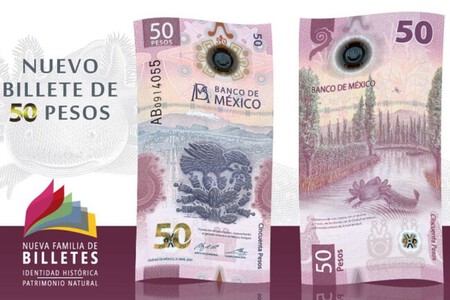The cultural phenomenon around the Mexican axolotl began with a seemingly modest gesture: its appearance on a banknote, part of a design process in which specialists in Xochimilco advised the Bank of Mexico to faithfully represent this unique species and its chinampero ecosystem. The initial intention was pedagogical and symbolic, but it ended up unleashing an unexpected enthusiasm of unknown dimensions.
The creature that conquered a country. As we said, the appearance in 2021 of the axolotl on the Mexican 50-peso bill completely transformed the country’s relationship with a species that, until then, was known only to specialists and residents of Xochimilco.
From the first day of circulation, the design captivated millions of people, not only for its aesthetics, but for the soft and enigmatic figure of the amphibian that, unintentionally, embodied a mixture of tenderness, identity and cultural pride.
Without millions in circulation. The bill became an immediate phenomenon: collectors, families and young people began to keep it as a small treasure, which explains why, more than four years later, the Bank of Mexico (Banxico) has announced through a report that 9.8 million Mexicans keep or collect this bill as if it were a treasure and have decided to remove it from circulation.
In fact, the bank has detailed that 68% of those consulted, who responded that they keep or collect this paper currency, have one to five units. According to the calculation, if 9.8 million Mexicans keep a 50 bill, it is estimated that around 490 million pesos of this currency, or its approximate equivalent of more than 26 million dollars, are out of circulation. Hallucinatory.
Awards. Its success even led to it being awarded internationally as banknote of the year, consecrating what was already intuited: the image of the axolotl had connected with a collective sensitivity that went far beyond the economic.
And behind that image there was a real animal, an axolotl named Gorda, selected after a careful process of documentation and photography, who ended up becoming a national figure without anyone planning it.
The daily life of la Gorda. Gorda currently lives in Axolotitlán, the National Axolotl Museum, where she remains in a deep and well-kept fish tank where she is no longer constantly exposed due to her advanced age. Even so, those who visit it can recognize it by small white spots on its head, a feature that ended up becoming its hallmark.
Its fame has generated a parallel ecosystem of objects and souvenirs (from stuffed animals to mugs and clothing) that have reinforced its presence in the country’s daily life. But beyond popular culture, specialists have recalled that admiration also implies responsibility: the axolotl is an extremely fragile species, dependent on a specific environment, and its sudden notoriety only makes sense if it translates into greater awareness about its conservation. Gorda’s story demonstrates that a single specimen can become a bridge between citizens and nature, but also that collective emotion must be accompanied by decisions that guarantee the survival of the species.


An extraordinary creature. The biological qualities of the axolotl, from its ability to regenerate limbs, tissues and even parts of the brain, to its breathing through gills, skin and mouth, or its condition as a salamander that does not complete metamorphosis, have made it a unique animal in the world.
However, this singularity coexists with a critical situation: Ambystoma mexicanum is classified as in extreme danger of extinction and the destruction of its habitat has been constant for decades. Xochimilco, the only place where this species exists naturally, faces a combination of threats: accelerated urbanization, water pollution and the presence of invasive species that have decimated native species since the 1980s.
And more. Added to this are improvised interventions, such as the release of axolotls without scientific protocols, which end in almost immediate mortality due to thermal shock, poor water quality or competition between specimens.
Specialists insist that axolotl conservation is not an act of isolated goodwill, but a technical process that requires strict control of the environment, genetic evaluation, slow acclimatization and comprehensive protection of the channels. The fragility of the animal reflects the fragility of the ecosystem that supports it.
Restore Xochimilco. Scientists say that the conservation of the axolotl is inseparable from the recovery of Xochimilco, and that evidence has led researchers and chinamperos to undertake refuge projects that recover ancestral agricultural techniques. These restored chinampas act as safe microecosystems where axolotls can remain free of contact with invasive species and with adequate water quality.
The objective is not to create artificial reserves, but to return the environment to its original balance so that the species can survive without eternally depending on human intervention. Xochimilco is not just a historical heritage site or a tourist postcard, it is a living system that regulates floods, stabilizes temperature, supports traditional agriculture and houses a biodiversity that depends on its continuity. The axolotl is only the visible tip of a much broader problem: if its home disappears, ecological functions on which the entire region depends will also disappear.

The hype. Be that as it may, the social phenomenon of the 50 peso bill demonstrated that an image can change the public perception of an entire species. Gorda became a symbol recognized by millions of people, capable of arousing curiosity, affection and an unexpected sense of identity.
But the true impact is not in the collection of banknotes or in the objects inspired by the axolotl, but in the opportunity it opened to understand that conservation is a deeply cultural act: only what is known is protected, and only what is cared for is what a bond is generated with.
The challenge in Mexico now is to convert that emotion into a sustained commitment. The bill gave visibility, and the restoration of Xochimilco will decide if that visibility has a future. The axolotl, meanwhile, has already occupied a place in everyday life, and now it is the country that must decide if it will also occupy a place in its future.
Image | Dgzvs2012
In WorldOfSoftware | We have discovered a megacity of spiders: a 100 square meter web where two enemy species live in peace
In WorldOfSoftware | In 1970, a zoologist released a species of rodent into the Caucasus to repopulate it. A century later the destruction is gigantic










